The collection was formed after the establishment of the Ethnographic Museum in 1901.
The main goal was to present the customs and costumes of Serbs and other peoples of the Balkans at world exhibitions. Men's, women's and children's costumes of the Serbian, Muslim and Catholic population were bought.
In multi-ethnic environments, the costume represented an important sign of the ethnic and religious affiliation, identity, status and wealth of the person who wears it. It was made from natural materials, and decorated most often with the skill of local artisans - terzija (tailor of folk costumes), abadžija (tailor of costumes made of coarse cloth) and kazaz (master of making silk items and ornaments).
The collection consists of 1085 items.
The curator in charge of the collection is Dr.Tatjana Mikulić, museum advisor: tatjana.mikulic@etnografskimuzej.rs
In multi-ethnic environments, the costume represented an important sign of the ethnic and religious affiliation, identity, status and wealth of the person who wears it. It was made from natural materials, and decorated most often with the skill of local artisans - terzija (tailor of folk costumes), abadžija (tailor of costumes made of coarse cloth) and kazaz (master of making silk items and ornaments).
The collection consists of 1085 items.
The curator in charge of the collection is Dr.Tatjana Mikulić, museum advisor: tatjana.mikulic@etnografskimuzej.rs

